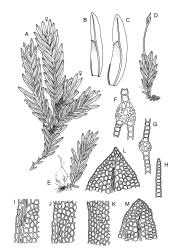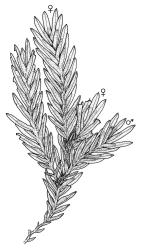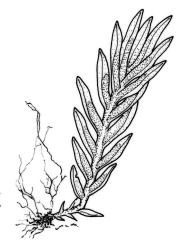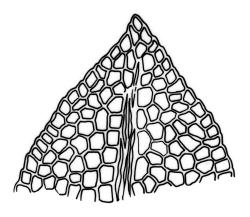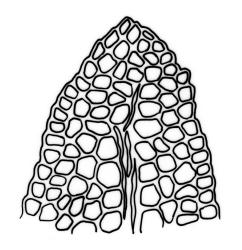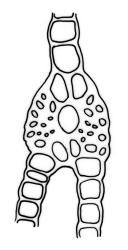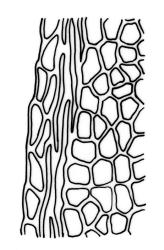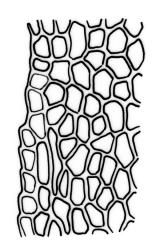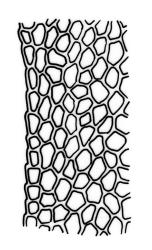Plants 5–15 mm, dark green to black, aquatic, in dense smooth mats or loosely gregarious. Stems frequently branched, with rhizoids at base of main and branch shoots and occasionally in leaf axils; branches readily detached. Leaves in 10–45 pairs, overlapping at mid stem, erect-spreading to patent, decurved when moist, little altered when dry, oblong-lanceolate, 1.2–2.0 × 0.25–0.35 mm; apex acute to obtuse; laminae unistratose; vaginant laminae ½–⅔ leaf length, open to half closed; dorsal lamina reaching leaf insertion and often shortly decurrent; margins serrulate; intramarginal cells usually distinct in 1–3 rows in proximal region of vaginant laminae, linear, vermicular, forming an intramarginal border, but border may be very weak or even absent; cells of apical and dorsal laminae quadrate to hexagonal, smooth, non-bulging, with moderately thick to incrassate walls, (8–)11–16(–20) × (8–)11–16(–20) µm. Costa failing 2–5 cells below the leaf apex, bryoides-type in cross-section.
Dioicous? and cladautoicous. Perichaetia terminal; perichaetial leaves narrower than vegetative. Perigonia terminal. Setae straw-coloured, stiff, 2.5–3.5 mm; capsules inclined, symmetric, 0.4–0.6 mm; exothecial cells in c. 30–56 columns; operculum rostrate from a conic base, equal in length to theca. Peristome scariosus-type; teeth with adaxial trabeculae below the bifurcation smooth, or with short, branched, and vermicular ornamentation, unusually wide at base for scariosus-type, 50–60 µm. Calyptra slightly scabrous at apex, mitrate. Spores 13–20 µm.
Wilson 1859, pl. 171, fig. 8; Willis 1951, figs A–E (as F. hunteri); Beever & Stone 1992, figs 3–5; Beever et al. 2002, p. 36, figs 1–6; Stone & Catcheside 2012.
Fissidens integerrimus has been assigned to subgen. Aloma (Pursell & Bruggeman-Nannenga 2004; Pursell & Müller 2008). The bryoides-type costa and scariosus-type peristome support this placement but, as is also the case for F. dealbatus, the number of columns of exothecial cells (up to c. 56) exceed the typical <40 columns for subgen. Aloma.
The species is similar to F. tumescens Pursell & Müller, a species from Dominica and Guadeloupe, which is sometimes aquatic (Pursell & Müller 2008) but seems to differ from F. integerrimus in its subpercurrent to percurrent costa, partially pluristratose laminae, and bulging lamina cells (inter alia).
Fissidens integerrimus occurs in the same habitat and is of similar size to F. strictus, but its oblong-lanceolate leaves, unistratose laminae, and often proximally bordered vaginant laminae will preclude confusion. Features distinguishing F. integerrimus from F. rigidulus var. rigidulus, F. rigidulus var. pseudostrictus, and F. waiensis are given under those taxa.
NI: N Auckland (N. Cape, Waipoua, Kerikeri, Puketī, Waitakere Ranges); Ch.
Australasian. Tasmania*, mainland Australia (Victoria)*.
On rock in streams and waterfalls, submerged or in splash zone, in northern indigenous forest, or (probably as relic populations) in streams through highly modified vegetation. Recorded at elevations from 40 m (Kerikeri River) to 325 m (Waitakere Ranges). Bryophyte associates include F. strictus and F. rigidulus var. rigidulus, and the hepatics Schistochila nitidissima and Jungermannia inundata.
Fissidens integerrimus is classified as "Nationally Vulnerable" in the N.Z. Threat Classification System (Glenny et al. 2011). The species is apparently rare and currently known from fewer than 10 sites, on the N. Auckland peninsula and the Chatham Is. However, the plants are small, dark, and frequently submerged; further collecting in streams may well show it to be more widespread. F. integerrimus also appears to be rare in Australia.
Mitten’s description of F. integerrimus (Wilson 1859) has caused confusion as it states that the leaf laminae are unbordered ("immarginatus"). Moderately well-developed intramarginal borders are, however, present on the proximal half of the vaginant laminae in the type specimen, as was noted by Sainsbury (1955). The borders are variably developed in N.Z. material and, in some specimens are extremely weak, consisting only of two or three elongate cells.
An account of F. integerrimus was given by Beever & Stone (1992).




